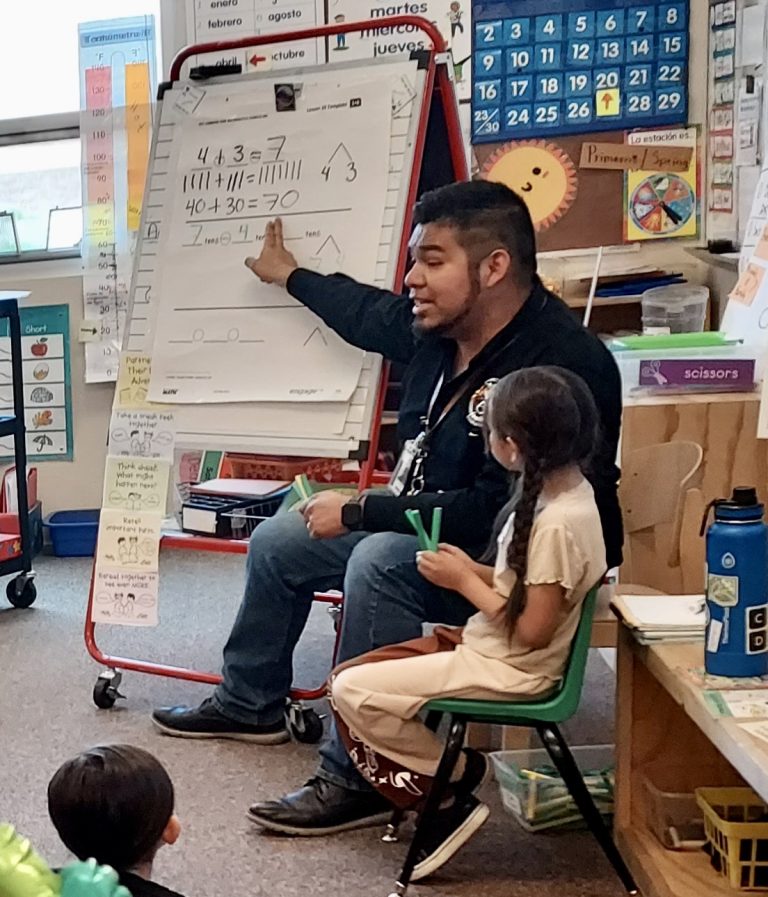
Amy Stone is a 4th grade teacher at Acequia Madre Elementary School in Santa Fe. This is her 9th year of teaching. She is a member of ISEC’s Teacher Leader Cadre.
What are the challenges of teaching science at the 4th grade level?
The biggest challenge I face as a 4th grade teacher teaching science is time. There is not enough time in a day to meet my personal expectations of myself and what I would like to teach the kiddos each day. By 4th grade it is easy to distinguish the science gaps amongst the students based on notebooking skills and inquiry abilities. Lessons that used to take one hour for the inquiry portion and writing portion now take anywhere from 1.5-2 hours, resulting in less lessons being taught and less exposure to science content while I build up their inquiry strategies and abilities and teach them how to notebook correctly.
How has the ISEC curriculum helped you with those challenges?
Inquiry science learning provides the opportunity for students to push themselves beyond simply learning to memorize or remember content, and toward applying knowledge in new areas both academically and in the real world. Inquiry science allows students to draw connections among ideas, evaluate or challenge ideas, and additionally to create something completely new. Inquiry-based learning experiences push students out of their comfort zone because it focuses more on exploring content of various levels of uncertainty, it lowers the students’ self expectation and need to “get it right” that would otherwise make students uncomfortable with intellectual risk-taking. In my classroom we believe we are not learning if we are not making mistakes.
Has the ISEC training helped you in your classroom with topics other than science? How?
I love the training the LANL Foundation has provided around the ISEC science curriculum. It has helped me become the teacher I am today. The training we provide teachers shift from teacher centered to student centered, shifting the attention from the instructor to the learner. The learner-centered education method opens up a two-way dialogue between teacher and student and among students. This method provides the opportunity to inquire from one another and ask real world questions we see occur in our classroom. Cooperative learning encourages students to work in pairs or groups. This works great when teachers are in training because we can learn from one another. This method encourages learners whether it be teachers or students to be active participants in their learning!
What is the importance of inquiry based learning to you?
Inquiry-based learning helps students focus on open questions or problems to use evidence-based reasoning, creative thinking, and problem solving to form a conclusion they can defend. Inquiry-based learning is important because it allows students to explore and ask questions about the real world around them. This type of learning helps students develop critical thinking and problem-solving skills. The 5 guiding questions of inquiry based learning are: 1) What? 2) So what? 3) Now what? 4) How? 5) Why? Inquiry-based learning is focused on student-driven research and exploration.
How has being a part of ISEC’s Teacher Leader Cadre supported your growth as a teacher?
I am a part of the Teacher Leader Cadre. I have been the Teacher Leader for Acequia Madre for 9 years!! The TLC is a safe, warm, positive opportunity for collaboration. The LANL Foundation goes above and beyond to make sure teachers feel supported and that their voices are heard. They respect our time, and understand how precious our time is. Over 9 years, I have learned so much from my Teacher Leader Cadre AKA my friends, along with the staff at the Foundation. With that being said I personally thank them with my sincerest gratitude for welcoming me into the TLC, and supporting me and my wild ideas! I truly believe from the bottom of my heart that the TLC teachers are some of the best EDUCATORS in the state of New Mexico, and I believe ALL teachers are the true unsung heroes of our community.
What’s your teaching philosophy?
I believe children learn best when they are welcomed into a positive environment which allows them to make personal choices and grow in responsibility. For a classroom environment to be welcoming, individual strengths of the children are imperative along with their culture and languages spoken. Allowing the children to take risks is encouraging and seen as a way of learning. This gives the students the opportunity to think for themselves and embrace their gifts and abilities in the classroom. My role as a teacher is to promote a classroom environment that focuses on delivering an education to each child’s strengths and needs. In order to do so, it is essential for me to facilitate learning, model proper behavior, develop knowledge, build background using prior knowledge, and provide my students with appropriate materials and resources to differentiate and inspire learning. Students learn best when they build their own knowledge through inquiry, exploration, and dialogue. Using inquiry and exploration in a classroom environment will enable children to become active contributors in the classroom. Optimism and encouragement is an influential tool in building success. Children thrive in a positive environment making the classroom new and exciting everyday. Children should be enthusiastic about coming to school each day. In order to build enthusiasm, I believe it is vital to publicly recognize children for their strengths and diverse contributions they bring to the classroom. By building their self-confidence, work ethic, and allowing them to take risks and make mistakes produces a classroom where new and positive ideas are adapted and applied.
Other than ISEC, what else is going on in your teaching and personal life?
I’ve been a Big Sister for 15 years with Big Brothers Big Sisters of Northern New Mexico. I have three fur-children – Hannah (Chihuahua), Kane (Pitbull), and Akela (German Shepherd). I am an only child, making my mom and dad my world. I am conquering my dreams with an AMAZING partner in crime (John), and three wonderful step-children – Jadrien, Harmony, and John Jr.


